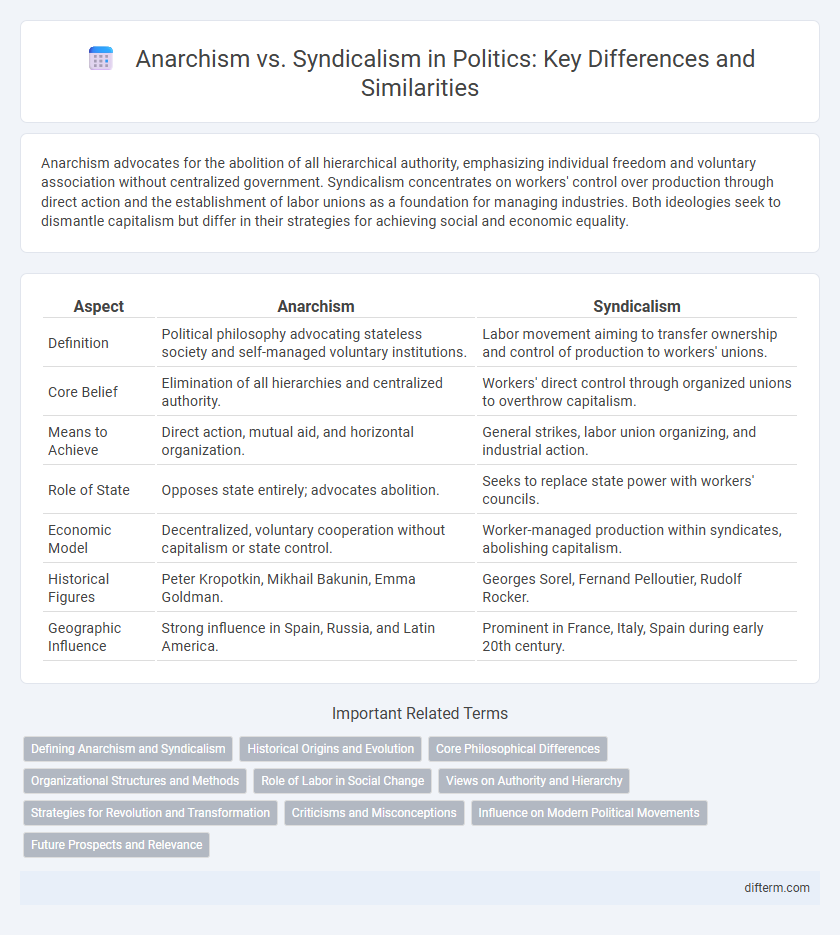Anarchism advocates for the abolition of all hierarchical authority, emphasizing individual freedom and voluntary association without centralized government. Syndicalism concentrates on workers' control over production through direct action and the establishment of labor unions as a foundation for managing industries. Both ideologies seek to dismantle capitalism but differ in their strategies for achieving social and economic equality.
Table of Comparison
| Aspect | Anarchism | Syndicalism |
|---|---|---|
| Definition | Political philosophy advocating stateless society and self-managed voluntary institutions. | Labor movement aiming to transfer ownership and control of production to workers' unions. |
| Core Belief | Elimination of all hierarchies and centralized authority. | Workers' direct control through organized unions to overthrow capitalism. |
| Means to Achieve | Direct action, mutual aid, and horizontal organization. | General strikes, labor union organizing, and industrial action. |
| Role of State | Opposes state entirely; advocates abolition. | Seeks to replace state power with workers' councils. |
| Economic Model | Decentralized, voluntary cooperation without capitalism or state control. | Worker-managed production within syndicates, abolishing capitalism. |
| Historical Figures | Peter Kropotkin, Mikhail Bakunin, Emma Goldman. | Georges Sorel, Fernand Pelloutier, Rudolf Rocker. |
| Geographic Influence | Strong influence in Spain, Russia, and Latin America. | Prominent in France, Italy, Spain during early 20th century. |
Defining Anarchism and Syndicalism
Anarchism is a political philosophy advocating for a society without hierarchical government structures, emphasizing voluntary cooperation and individual freedom. Syndicalism is a labor movement and economic theory that promotes direct action by workers through trade unions to control production and establish workers' self-management. Both ideologies seek to dismantle centralized authority but differ in strategy; anarchism focuses on abolishing all forms of coercion, while syndicalism targets workplace organization as a means to achieve social revolution.
Historical Origins and Evolution
Anarchism emerged in the 19th century as a political philosophy advocating for stateless societies based on voluntary cooperation, with roots tracing back to thinkers like Pierre-Joseph Proudhon and Mikhail Bakunin. Syndicalism evolved concurrently, especially prominent in France and Spain, emphasizing direct action and labor unions as means for workers to seize control of industries and dismantle capitalism. Both movements influenced each other, with syndicalism adopting anarchist ideals while focusing on organized labor strategies during the late 19th and early 20th centuries.
Core Philosophical Differences
Anarchism advocates for the complete abolition of hierarchical structures and state authority to achieve a stateless, self-managed society, emphasizing individual freedom and voluntary cooperation. Syndicalism, while also opposing centralized state power, focuses on labor unions as the primary agents of revolutionary change, promoting direct worker control of production through organized syndicates. The core philosophical difference lies in anarchism's broader rejection of all forms of imposed authority contrasted with syndicalism's strategic emphasis on organized labor as the vehicle for societal transformation.
Organizational Structures and Methods
Anarchism advocates for decentralized, non-hierarchical organizational structures that emphasize voluntary association and direct action without formal leadership. Syndicalism supports structured labor unions as the primary method to achieve worker control, promoting collective bargaining and coordinated strikes within federations. Both frameworks reject state authority but diverge in approaches: anarchism favors spontaneous grassroots organization, while syndicalism relies on organized, union-based strategies to dismantle capitalism.
Role of Labor in Social Change
Anarchism emphasizes direct worker control and dismantling hierarchical structures to achieve social change, viewing labor as the foundation for creating a stateless society. Syndicalism advocates for labor unions as the primary agents of revolution, using organized strikes and collective bargaining to transfer economic power to the working class. Both ideologies position labor as a crucial force in overthrowing capitalist systems and establishing egalitarian social orders.
Views on Authority and Hierarchy
Anarchism fundamentally rejects all forms of authority and hierarchical structures, advocating for a stateless society where individuals freely cooperate as equals. Syndicalism embraces worker-managed unions as central authority units, supporting hierarchical organization within labor collectives to coordinate economic activity. The core divergence lies in anarchism's absolute opposition to institutional hierarchy versus syndicalism's pragmatic acceptance of structured leadership for collective worker empowerment.
Strategies for Revolution and Transformation
Anarchism advocates for the immediate abolition of the state and hierarchical institutions through decentralized, direct action and spontaneous mass uprisings, emphasizing individual autonomy and voluntary cooperation. Syndicalism focuses on building revolutionary industrial unions as dual power structures to gradually supplant capitalism and the state through organized strikes and worker control of production. Both strategies aim to dismantle existing power systems but differ in their approach; anarchism prioritizes decentralized insurrection while syndicalism relies on structured labor organization as a vehicle for systemic transformation.
Criticisms and Misconceptions
Anarchism faces criticism for perceived impracticality and potential for disorder, while syndicalism is often misunderstood as solely trade unionism rather than a revolutionary strategy for worker control. Critics argue anarchism overlooks the need for organized structures, whereas misconceptions about syndicalism include conflating its goals with reformist labor movements. Both ideologies are frequently misrepresented in mainstream discourse, obscuring their nuanced critiques of capitalism and state power.
Influence on Modern Political Movements
Anarchism's influence on modern political movements is evident in its advocacy for decentralized power and direct action, inspiring contemporary grassroots and anti-authoritarian campaigns worldwide. Syndicalism's emphasis on labor unions and worker control has shaped modern labor movements and social justice initiatives, particularly in promoting collective bargaining and economic democracy. Both ideologies contribute to the broader discourse on resistance against centralized authority and the pursuit of egalitarian social structures.
Future Prospects and Relevance
Anarchism and syndicalism continue to shape debates on labor rights and decentralized governance, with anarchism emphasizing stateless societies and individual autonomy while syndicalism focuses on worker-controlled industries through unions. Emerging technologies and global labor shifts present opportunities for syndicalism to gain traction as unions adapt to gig economies, whereas anarchism remains influential in grassroots activism advocating systemic change beyond traditional political frameworks. The intersection of both ideologies suggests evolving potential for cooperative organizational models that challenge hierarchical power structures in the 21st century.
anarchism vs syndicalism Infographic

 difterm.com
difterm.com